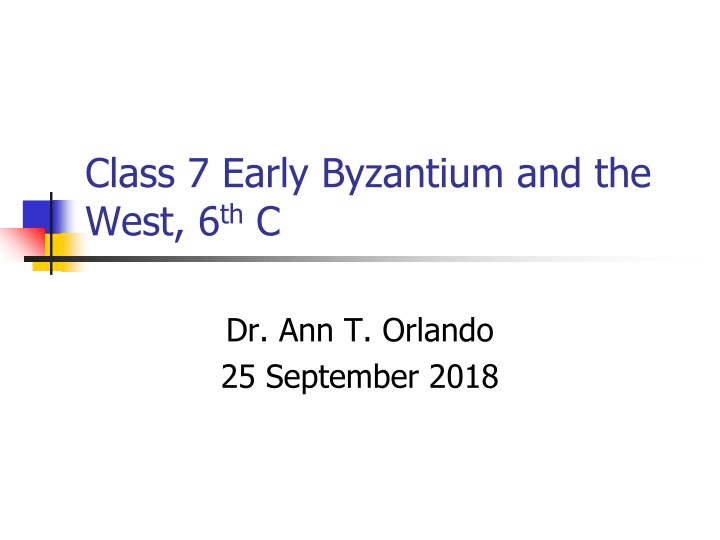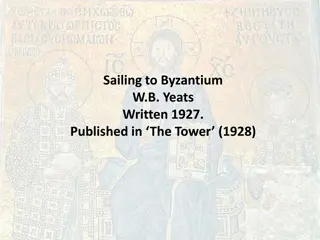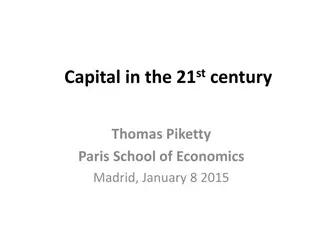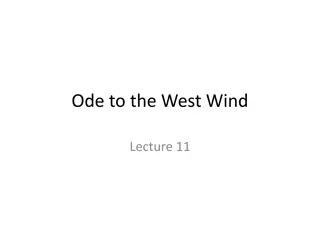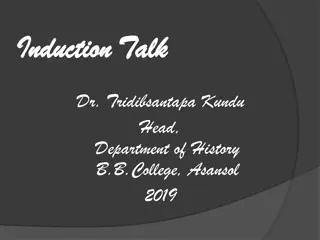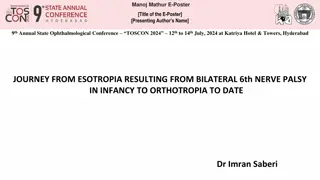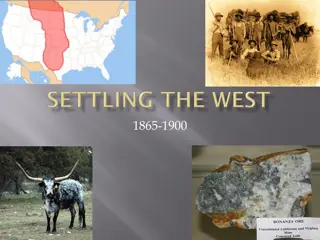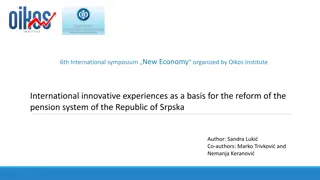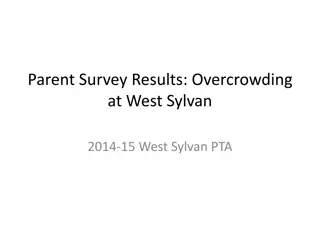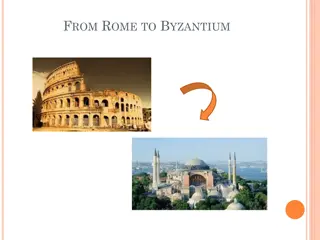Early Byzantium and the West: 6th Century Insights
Delve into the historical intersection of Early Byzantium and the Western world in the 6th century with Dr. Ann T. Orlando on September 25, 2018. Explore the cultural exchanges, political dynamics, and religious influences that shaped this period, uncovering connections between these two significant regions during a transformative era. Gain a deeper understanding of the complexities and developments that characterized this time through expert analysis and engaging discourse.
Download Presentation

Please find below an Image/Link to download the presentation.
The content on the website is provided AS IS for your information and personal use only. It may not be sold, licensed, or shared on other websites without obtaining consent from the author.If you encounter any issues during the download, it is possible that the publisher has removed the file from their server.
You are allowed to download the files provided on this website for personal or commercial use, subject to the condition that they are used lawfully. All files are the property of their respective owners.
The content on the website is provided AS IS for your information and personal use only. It may not be sold, licensed, or shared on other websites without obtaining consent from the author.
E N D
Presentation Transcript
Class 7 Early Byzantium and the West, 6thC Dr. Ann T. Orlando 25 September 2018
Roman Emperors and Councils Constantine (r. 313 335) Council of Nicaea Opposed Arians Theodosius I, Great (r. 379-395) Council of Constantinople Opposed Arians Arcadius (son of Theodosius) and Eudoxia in East (r. 395-408) Conflicts with John Chrysostom Theodosius II (r. 408-450) Son of Arcadius Council of Ephesus Opposed Nestorians St. Pulcharia and Marcion (r. 450-457) Pulcharia daughter of Theodosius II Council of Chalcedon Opposed Monophysites Justinian (r. 527-565) Attempts to reconquer Western Roman Empire Second Council of Constantinople Reaffirm Chalcedon Constantine Pogonatus (r. 668-685) Third Council of Constantinople Opposed Monothelites St. Irene (r. 797-803) Second Council of Nicaea Opposed Iconoclasts
Council of Ephesus and Nestorians Although Council of Ephesus condemns Nestorian Christology (complete separation of Christ s divinity and humanity), not all follow Council Mary not Theotokos Opposed Orthodox Patriarch and Emperor in Constantinople Distinct Nestorian Church established in Mesopotamia and Persia Theodore of Mopsuestia seen as founding theologian Nestorius as founding patriarch Syriac is liturgical language Nestorian Christianity affected development of Christianity further East, including India
Syriac Christian Faithful to Chalcedon and Rome (but not politically to Constantinople) Melkite (Syriac for king) Christians are theologically in agreement with Chalcedon Politically support Constantinople, in 5th 8thC After schism, remain in union with Rome, although continue to follow a Byzantine liturgy
Further Divisions Between Orthodox (Byzantine) and those in Communion with Rome Maronite St. Maron (d. 408) friend of St. John Chrysostom founds a monastery near Antioch (if he existed??) Orthodox Christians associated with this region form a strong regional identity and militia In 7thC Byzantine army (Justinian II) attacks them and Byzantine army is defeated. St. John Maron appeals to Rome and is accepted into communion with Rome by Pope Sergius I Eventually, Maronite Catholics (in communion with Rome but at odds with Constantinople) migrate to Lebanon NB Melkite Christians and Maronite Christians have at times been hostile toward each other
Council of Chalcedon, 451 Called by St. Pulcharia and Marcian Establishes the Christological formula that Pope St. Leo the Great suggested Primarily bishops from the East, with a representative from Rome Dioscursus and much of the Alexandrian Church refuse to accept Chalcedonian Christology Politically this remained a divisive issue in the East until rise of Islam Theologically it remains a divisive issue to the present day; Coptic Christians
Leo and Papal Primacy Sermon 3, delivered on the anniversary of his election to pontificate Peter s work is continued in his successors (heirs) Priesthood conferred from Christ through Peter Council Chalcedon by tradition acclaimed on hearing Leo s Tome, Peter has spoken through Leo.
Chalcedonian Divisions among Christians Refusal is partly theological, but also in opposition to political control from Constantinople Alexandrian (Coptic) Christians who refused to accept Chalcedon Egyptian Ethiopian Numerous Syriac Christian Churches develop based on Patriarchate of Antioch Syriac Orthodox (non-Chalcedonian) Jacobite Assyrian Eastern Church
Acacian Schism (484-519) To try and bring monophysites back into union with Constantinople, in 484, Patriarch of Constantinople, Acacius, with Emperor Zeno, creates an edict of union (Henotikon) Affirms Christ s divinity, but makes no mention of His humanity Rejected by Pope Felix II in 485 He excommincates Acacius Division between Rome and Constantinople stands until 519 Pope St. Hormisdas reaches an agreement with Emperor Justin I, excommunications are lifted But monophysites (Alexandria) reject renewed union of Rome and Constantinople
Second Council of Constantinople, 553 Called by Emperor Justinian (nephew of Justin I) to try and reunite non-Chalcedonian Christians, especially Egyptian Christians To try and appease Alexandrians, Council condemns both Origen and Theodore of Mopsuestia Justinian s wife, Theodora, tries unsuccessfully to push theology more toward monophysite theology
Eastern Reaction to Barbarian Invasions: (St. ?) Justinian the Great (482-565) Justinian manages to reconquer most of Western Mediterranean from Vandals, Visigoths and Ostrogoths Reworked Roman Law; basis for law in East until Fall of Constantinople, 1453 Rebuilt Ravenna as capital of Western Empire to oppose Theodoric Boethius (480-524) Consolation of Philosophy Justinian considered a saint in East His wife, Theodora, is another story Proculus Secret History http://employees.oneonta.edu/farberas/arth/arth212/san_vitale.html
Byzantine Empire Some historian begin the Byzantine Empire with Justinian Byzantine is a 19thC term Greek-speaking, Eastern Roman Empire Endure until 1453 Greatest enemy rises in the 7thC from the Arab deserts: Islam
Why Justinians Efforts to Reconquer Failed Political/religious resentment toward Constantinople in Alexandria and Antioch Theological (and therefore political) divisions in Syria and Egypt Bubonic Plague Outbreak in 541 Killed about 1/3 population of Constantinople and Eastern Mediterranean
Cassiadorus (490-583) Roman senator and supporter of Theodoric Captured by Justinian's general (Belisarius) Retired and established a monastery on his estates (possibly influenced by Benedict) Wrote extensively on theological and contemporary events Was especially complementary of Goths Among his treatises support for legal procedure that states that a cleric accused of a civil crime must be tried by his bishop
Ecclesial Importance of Hagia Sophia Cathedral Church for most important Eastern Bishop, the Patriarch of Constantinople Original built by Constantine Rebuilt by Justinian after an earthquake in 537 Many important theologians were associated with Hagia Sophia; Greek Fathers and Doctors of the Church St. Gregory Nazianzus (325-389, Feast Day Jan 2) St. John Chrysostom (347-407, Feast Day Sept 13 ) http://upload.wikimedia.org/wikipedia/commons/thumb/c/cf/Johnchrysostom.jpg/220px-Johnchrysostom.jpg
Later History of Hagia Sophia http://www.byzantines.net/epiphany/hagiasophia.htm Conquered by Turks in 1453, converted to a mosque; mosaics covered over Changed to a museum by Ataturk in 1935, mosaics start to be uncovered Why such importance deal that Benedict XVI might pray there on his journey to Turkey? 09sophia
Caesaropapism Society in which head of government is also head of Church Notice that all these early (eastern) councils are called by Emperors Constantine considered a saint in the East, equal to Apostles Revived civil Roman law includes canonical law in East Theodosian Code (Theodosius II), 438, takes 312 as the beginning of legal precedents Justinian Code, 534 This will be the Church-State model in Byzantium until 1453 (in Russia until 1917)
A Different Development in West: Pope Gelasius Pope 492-496; West being overrun with barbarians Only civil authority with continuity to Roman Empire was Church Eastern Emperor (Anastatius) claims authority in West, but has no military capability to back it up Gelasius Letter to Anastatius is a landmark in defining balance of power relation between altar and throne Two authorities in world: consecrated priests and royal power Each has its own sphere of operation and respect Priests have greater responsibility; emperor should obey priests This view was never accepted in East; however became the basis of operation for Middle Ages in West Pope Leo III crowns Charlemagne Holy Roman Emperor in 800 Note: Papacy is only real continuing link between East and West from 476 onwards Gelaisus Letter will be used by Papacy throughout Middle Ages to justify Papal stance with respect to Western Rulers
Another Development in the West: Beginning of Catholic Christianity Among Franks Conversion of Chlodwech (Clovis) 496 in Rheims as a Catholic Christian Becomes a Catholic because attributes his victories against other tribes to St. Martin of Tours Baptized by St. Remigius bishop of Rheims (437-533; Feast Day 1 October), Emperor Anastasius so pleased to have an orthodox German leader, he makes Clovis a consul Clovis is beginning of Merovingian dynasty in France After Clovis, there are close ties between Frankish king and the papacy Clovis kingdom divided among his sons History of Franks written by St Gregory of Tours (538-594) 20
St. Fortunatus (530 607) Christian poet and hymnist Born in Italy, but spent most of his life in Poitiers Associated with monastery (convent) of St. Radegunde This was politically a very important monastery; St. Radegunde was in frequent communication with Constantinople Fortunatus was a close friend of St Gregory of Tours Eventually became bishop of Poitiers His two most famous poems/hymns are Pange Lingua and Vexilla Regis
Assignment Pope Gelasius, Letter to Emperor, http://www.fordham.edu/halsall/source /gelasius1.asp
